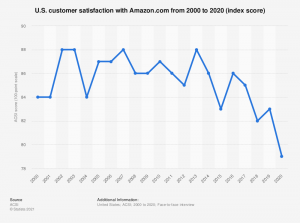It’s no surprise that the power of eCommerce has grown at the scale and speed that it has. This growth is due, in large part, to the Amazon Effect. If you haven’t heard this term before, no need to worry – this blog will explain everything you need to know about the Amazon Effect.
What is the Amazon Effect?
The Amazon Effect is the significant disruption created by the increase of eCommerce retail. The disruption can be described as the impact on brick-and-mortar businesses, the impact on the supply chain and delivery process, and the impact on pricing products. The Amazon Effect got its name from the eCommerce giant Amazon, as they are the ones leading the eCommerce marketplace.
The Power of Amazon
It is undeniable that the impact of Amazon has impacted the way consumers purchase products. Amazon was the spearheader in online shopping, the champion of making shopping accessible to all. In fact, in the list of most popular multi-platform web properties in the United States in June 2021, Amazon had 214.43 million unique visitors (Statista, 2021). This number is only 55.72 million behind the most popular web platform, Google Sites.
Out of the 214.42 million unique visitors, there are 200 million paying Amazon Prime members. Similarly, in 2015, this number was only 46 million (Statista, 2021), representing a growth of 366%. From Prime memberships alone, Amazon has made 23.8 billion dollars. These numbers represent the massive growth that Amazon has had in the last five years.
With no help from the Coronavirus pandemic, small businesses and brick and mortar stores have felt the crushing impact. As a result, many stores are closing, and companies have had to switch their revenue models to stay afloat. Businesses began to create online shops to keep up with the changing trends.
The Impact of the Amazon Effect on Delivery Businesses
Beginning with the supply chain effects, Amazon has drastically increased their fulfilment centers across North America. By building more fulfilment centers across major cities, Amazon can get packages in customers’ hands in shorter delivery windows. Amazon members can get packages delivered the same day they ordered in the United States. As a result, this service has made shopping online a very close equivalent of in-person shopping.
Amazon has also significantly altered consumer expectations for delivery services. Across the board, consumers now expect deliveries to arrive within 1-3 days of purchasing a product online. If products are not received within that time frame, customers begin to worry about their products and consider reaching out to the store to inquire. Businesses now need to provide adequate delivery services, but companies are struggling due to the high delivery cost.
Diving in deeper, Amazon customers experiences free shipping with the Prime membership. Customers can order as many times as they want without being charged for delivery with their monthly subscription. As a result, smaller eCommerce businesses cannot match this volume and often need to charge customers for shipping. If companies begin incorporating shipping into their product prices, consumers will be less likely to spend more money on the product. The only other option is for the small store to lose money to cover the cost of shipping. All of these solutions are not ideal.
The Future
Ecommerce stores need a delivery solution that puts them at the same level as Amazon, without paying exorbitant shipping prices for every package. This dilemma causes space in the supply chain and logistics industry for businesses to make fast and reliable deliveries accessible to all. For example, FlashBox is a same-day delivery service doing just that. We make delivery affordable, charging only $6 per parcel, with a three parcel minimum. Our service provides delivery across the GTA, with drivers coming to storefronts, warehouses or homes to pick up packages. Indeed for such low prices, eCommerce businesses would be foolish not to switch from their take up these savings.
One important statistic to note is that Amazon’s customer satisfaction has drastically declined over the last ten years. In 2020, customer satisfaction was at only 79%, a steep decline from its previous peak of 88% in 2013 (Statista, 2021).

This statistic is crucial because it creates room for small to medium-sized eCommerce companies to swoop in and convert some Amazon customers. By capitalizing on Amazon’s declining customer satisfaction, businesses can increase their customer base. Companies will need to focus on providing quality products at affordable prices and avoid charging excessive delivery fees to do this successfully.
Conclusion
In short, the Amazon Effect has taken over retail sales and has paved the way for small and medium-sized eCommerce businesses to join the market. Amazon has set the industry standard for product prices and delivery times by fostering the online shopping world. For this reason, other eCommerce businesses need to find a way to keep up with Amazon and appeal to Amazon shoppers. If companies don’t, they risk losing out to Amazon.
Therefore, if you own an eCommerce business and are looking to improve your delivery experience for your business and your customers, Talk with one of our delivery experts today about your delivery needs.







